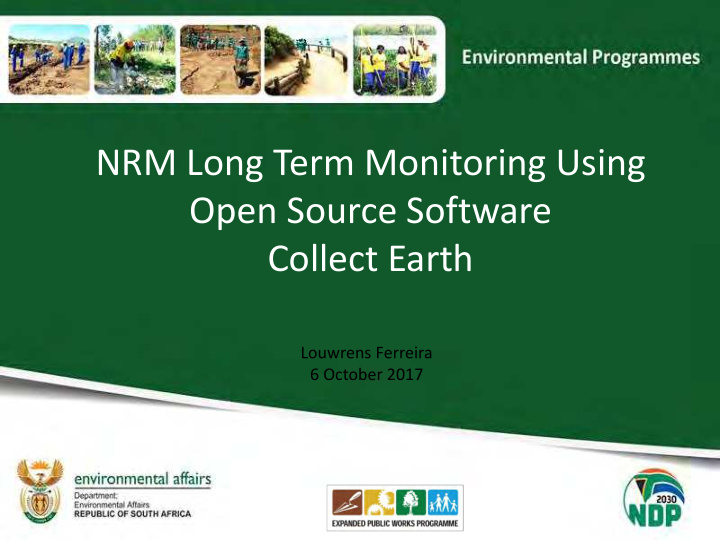



NRM Long Term Monitoring Using Open Source Software Collect Earth Louwrens Ferreira 6 October 2017
Introduction • The natural resource management programme started out in 1995 and was only known as Working for Water • The main focus was to create jobs for the unemployed and address the ever increasing problem water scarcity. • To do this the programme focused on the removal of invasive alien species that consume large amounts of water. • Doing this resulted in the release of millions of litres of water in strategic places.
Introduction • NRM captured all the data on an system called the Working for Water Information Management System, or in short WIMS • Data has been captured since around 1998 that gives us almost 20 years of data. • The Data on the system gives us an idea of what the sites looked like at a specific point in time. This was captured by staff members in field • The programme then appointed and trained unemployed participants to remove the invasive aliens. • The information was then updated on the system and a picture of that area could be created. • Information included the species, density, cost, time and number of people. • This gives the user a good idea of what happened on the ground. • This information could then be used to calculate the gains
The Problem • Calculating the densities is not an exact science at the scale it was needed • Data is captured at a specific time and once the work is done no follow up capturing is done for that site • The site could be in 3 states, cleared, not cleared, Follow up. • Point in time specific • The data is accurate at one point in time and decreases as time passes.
The Problem • So what has happened over time?? • Regrowth • Still clear • Other condition, Flood, Fires • These factors would effect the delivery of water
Monitoring of Historic work • Monitoring and comparing WIMS data becomes essential when calculating impacts • Best solution would be to do this in real-time, something that we are working on. • Looking back at historic data will also help us to improve the way we work in the future
Open Source Software: Google Earth and Collect Earth • Google earth has images dating back to 2003 (South Africa) • GE does not allow manipulation of the images and can therefore not be used in a GIS • Collect earth partially solves this problem. • Making use of visual ques you can map the change of a specific plot. • https://www.youtube.com/watch?v=3cxyFXt15aM
NRM Specific Monitoring • Collect earth needs to be customised to fit what we are trying to achieve. • Mapping change over time in a WFW cleared site • Comparing this to our WIMS data • We need to build custom forms to collect the appropriate data. • Need to identify some historic sites, where work has been completed
NRM Specific Monitoring • Then we need to sit and capture the data for the selected site, going as far back as possible. • This process is very time consuming and will not work for very large area • The results will then be analysed and compared
Results • What do we expect/Hope to see • A declining infestation relegating to when resources were allocated. • A Direct correlation between WIMS and Collect earth.
Results • Any anomalies can then be identified and investigated • This could assist us to improve the way we implement in the future • This will give us an indication regarding the accuracy of our WIMS data • Will assist us to improve the way we capture data • Other uses might include monitoring effects of biocontol in the long term. • This project will start mid October 2017 and should have its first results In December.
Recommend
More recommend